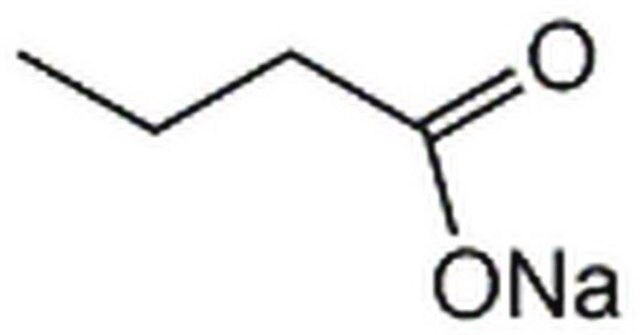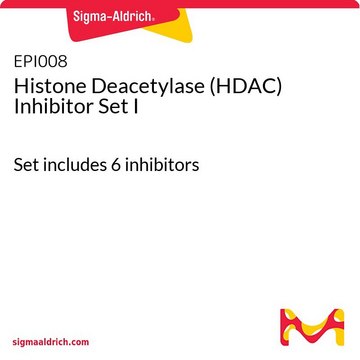Alle Fotos(1)
Wichtige Dokumente
EPI005
Histone Deacetylase 3 (HDAC3) Inhibitor Screening Kit
100 assays in 96 well plates
Anmeldenzur Ansicht organisationsspezifischer und vertraglich vereinbarter Preise
Alle Fotos(1)
About This Item
Empfohlene Produkte
Verwendung
100 assays in 96 well plates
NCBI-Hinterlegungsnummer
Versandbedingung
dry ice
Lagertemp.
−20°C
Angaben zum Gen
human ... HDAC3(8841)
mouse ... HDAC3(15183)
Allgemeine Beschreibung
Histone deacetylases (HDACs) are a large family of enzymes that remove acetyl groups from histone proteins. Site specific histone acetylation and deacetylation have been shown to activate or repress eukaryotic gene transcription, respectively, and as a consequence, HDACs play a crucial role in mammalian development and disease. HDACs are involved in important biological activities, such as cell differentiation, proliferation, apoptosis, and senescence. Of the several classes of HDACs, this kit assays a member of the zinc-independent, NADH requiring class, HDAC3. With Sigma′s HDAC3 Inhibitor Screening Kit, HDAC3 Enzyme acts with the supplied Developer to deacetylate and then cleave the HDAC3 Substrate [Arg-His-Lys-Lys(Ac)-AFC]. This activity releases the quenched fluorescent group, AFC, which can be detected at Em/Ex=380/500 nm. In the presence of a HDAC3 inhibitor, AFC is not released and its fluorescence remains quenched. The kit provides a rapid, simple, sensitive, and reliable test, suitable for either individual tests or high throughput screening of HDAC3 inhibitors. Trichostatin A (TSA) is included as a control inhibitor to compare with the efficacy of test inhibitors.
Leistungsmerkmale und Vorteile
- Simple, sensitive, and reliable assay
- Simple procedure; takes ~60 min
- Utilizes fluorometric methods
- Sample type: candidate HDAC3 inhibitors
- Suitable for screening HDAC3 inhibitors
- Suitable for individual tests or high throughput assays and kinetic studies
- Convenient 96-well microplate format
Sonstige Hinweise
The kit is shipped on dry ice. Store HDAC-3 enzyme at -80 °C upon receipt. All other components should be stored at -20 °C, protected from light. All -20 °C reagents should be used within 2 months after thawing.
Ähnliches Produkt
Produkt-Nr.
Beschreibung
Preisangaben
Lagerklassenschlüssel
10 - Combustible liquids
WGK
WGK 3
Flammpunkt (°F)
188.6 °F - closed cup
Flammpunkt (°C)
87 °C - closed cup
Analysenzertifikate (COA)
Suchen Sie nach Analysenzertifikate (COA), indem Sie die Lot-/Chargennummer des Produkts eingeben. Lot- und Chargennummern sind auf dem Produktetikett hinter den Wörtern ‘Lot’ oder ‘Batch’ (Lot oder Charge) zu finden.
Besitzen Sie dieses Produkt bereits?
In der Dokumentenbibliothek finden Sie die Dokumentation zu den Produkten, die Sie kürzlich erworben haben.
Ji Heon Noh et al.
Cancer research, 74(6), 1728-1738 (2014-01-23)
Aberrant regulation of histone deacetylase 2 (HDAC2) contributes to malignant progression in various cancers, but the underlying mechanism leading to the activation of oncogenic HDAC2 remains unknown. In this study, we show that HDAC2 expression is upregulated in a large
Astrid M Kral et al.
Biochemistry, 53(4), 725-734 (2014-01-24)
Histone deacetylases (HDACs) play diverse roles in many diseases including cancer, sarcopenia, and Alzheimer's. Different isoforms of HDACs appear to play disparate roles in the cell and are associated with specific diseases; as such, a substantial effort has been made
Johannes Gräff et al.
Cell, 156(1-2), 261-276 (2014-01-21)
Traumatic events generate some of the most enduring forms of memories. Despite the elevated lifetime prevalence of anxiety disorders, effective strategies to attenuate long-term traumatic memories are scarce. The most efficacious treatments to diminish recent (i.e., day-old) traumata capitalize on memory updating
Ouafa Zerzaihi et al.
Biochemistry and cell biology = Biochimie et biologie cellulaire, 92(1), 61-67 (2014-01-30)
Besides its direct metabolic effects, insulin induces transcriptional alterations in its target tissues. However, whether such changes are accompanied by epigenetic changes on the chromatin template encompassing insulin responsive genes is unclear. Here, mRNA levels of insulin-responsive genes hexokinase 2
Nicole L Regna et al.
Clinical immunology (Orlando, Fla.), 151(1), 29-42 (2014-02-08)
We sought to determine if a specific class I and II HDAC inhibitor (ITF2357) was able to decrease disease in lupus-prone NZB/W mice through regulation of T cell profiles. From 22 to 38 weeks-of-age, NZB/W and non-lupus NZW mice were
Unser Team von Wissenschaftlern verfügt über Erfahrung in allen Forschungsbereichen einschließlich Life Science, Materialwissenschaften, chemischer Synthese, Chromatographie, Analytik und vielen mehr..
Setzen Sie sich mit dem technischen Dienst in Verbindung.







